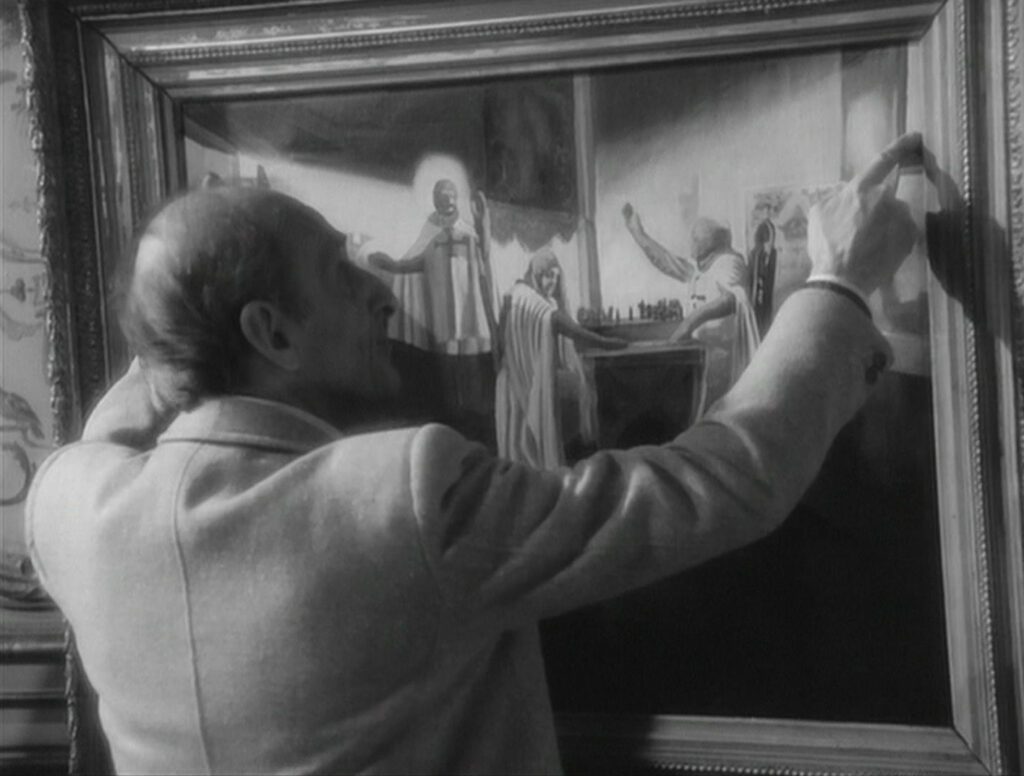
The Hypothesis of the Stolen Painting
1978, directed by Raúl Ruiz
To borrow a favorite phrase from the collector who guides us through The Hypothesis of the Stolen Painting, “it will not escape anyone” that the purported series of seven paintings is a metaphor for cinema. While it’s not unusual for paintings to come in a series, centuries of evolution in thought and technique have taught painters to create narrative – and audiences to recognize narrative – even on a single two-dimensional canvas. If you want to discuss the narrative qualities of painting, a single painting will do. The chief advantage of the series in this movie is that it affords the possibility of a heretofore unnoticed missing element. This grand ellipsis mirrors the smaller ellipses between consecutive paintings, but it’s the larger ellipsis around the hypothetical missing fourth painting that allows the collector to make sense of the four remaining smaller ones. Still, all these ellipses, which require elaborate explanation from the collector’s trained eye, would be entirely natural in a movie. Like this series of Tonnerre paintings, a film is a chain of images linked by cues, and movie audiences are usually more than ready to fill in the gaps between images.
Judging by the year the Salon rejected the fifth painting, the controversial series of Tonnerres was likely painted in or shortly before 1887. Two reviews are quoted from 1889. The paintings therefore come from the period leading up to the Lumière brothers’ invention of the cinematograph, a time in which serial photographic devices like the zoetrope and praxinoscope were already in use. The first celluloid motion pictures were made in 1888, so these paintings coincide squarely with the birthing of cinema. If Tonnerre and his paintings were not fictional, we could say that the cinematic impulse was trying one last time to find expression in the ancient medium of painting. One of the quoted critics describes Tonnerre as joining a novelist’s skill to that of a painter – a marriage of qualities that largely defines the art of moving pictures.
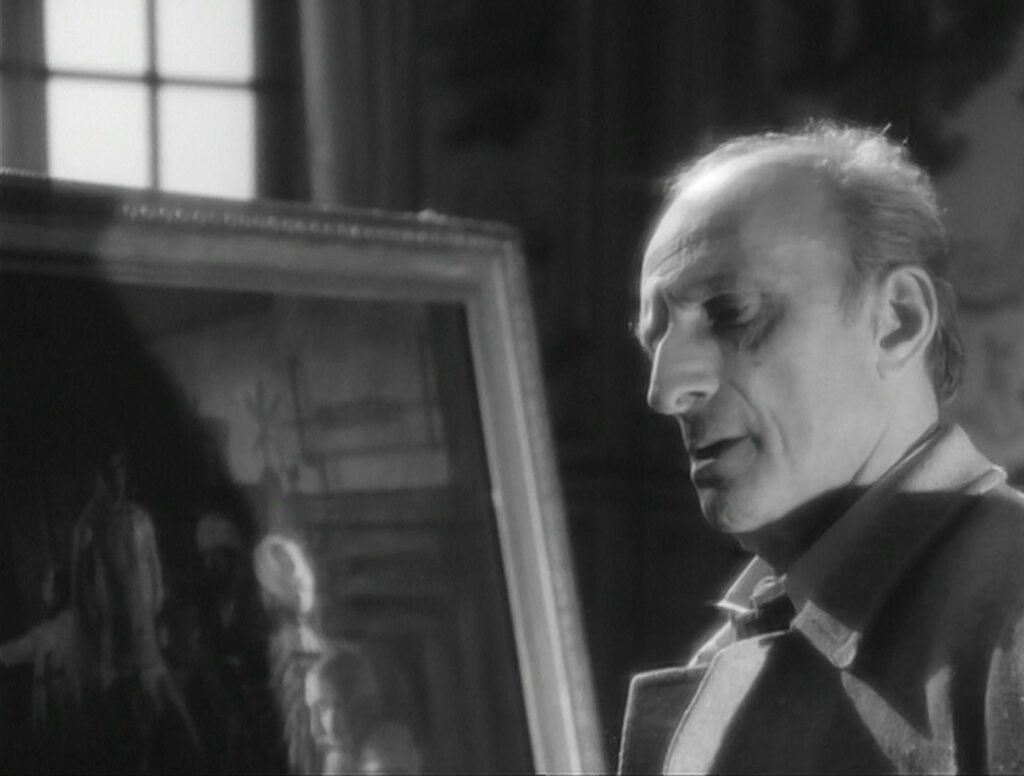
Whenever the collector tells us that a certain observation will have escaped no one, we might hear a note of mock sincerity. Of course his observations require some reflection, as do any parallels between the Tonnerres and cinema. But the challenge in Ruiz’s film, more than recognizing this similarity, is to define what those paintings, their reenactment, and their legend reveal about our own age’s dominant medium of narrative. Most of us are so familiar with moving pictures that we’ve lost the sense of wonder that should accompany them. Ruiz’s film aims to erode that familiarity.
For one thing, The Hypothesis of the Stolen Painting confronts us with the inherent strangeness in the experience of watching a movie – a strangeness most viewers overlook today, but which the first film audiences must have been well attuned to. The first thirteen minutes are a somewhat mysterious conversation between the collector and an unseen interlocutor. A profusion of human figures – in the paintings, a desk full of plastic dolls, an anatomy chart, and a couple of mannequins – only heightens the sense of stillness in the large house. But then the collector takes his binoculars to a window and introduces us to the first tableau vivant. Three living humans stand in the garden reenacting the mythic painting of Diana and Actaeon. How long have they been there? Has the collector given them an unseen signal to assume their poses? For whose benefit have they taken the trouble to gather there? They seem alive, yet after all those dolls and mannequins our eyes may take a few seconds to be sure these models are truly animate. As the collector guides us from one living tableau to another, we find each scene (with one exception) arranged in advance. It feels almost as if we’re looking at ghosts. Early film audiences must have experienced a similar cognitive dissonance watching people move across the screen.
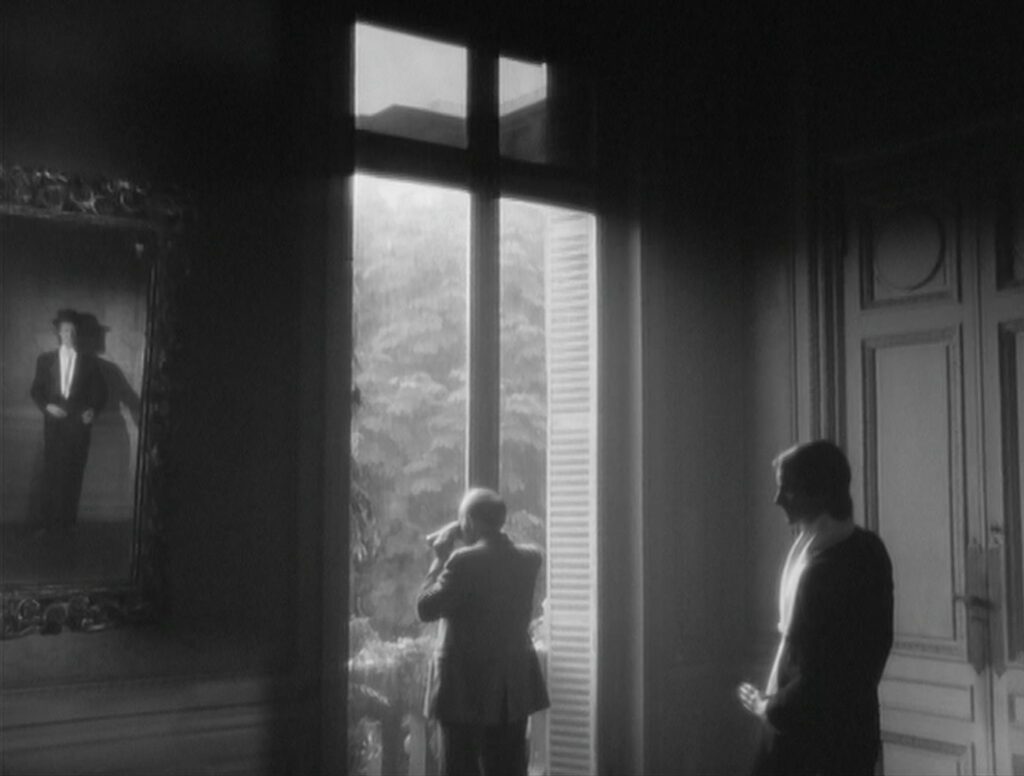
Not once does the collector engage with a single actor… they all remain as mute as characters in a silent film. Gradually however the human models relax their poses, wander out of their scenes, and begin to mingle in the house, so that by the end the collector weaves among them as he walks to the exit. The transformation is akin to becoming absorbed in a movie. The viewer remains separate from the characters but forgets they’re framed by a screen (in the case of a movie) or a doorway (for the living tableaux). The characters draw closer to us as our imagination lets us float through their world or fit them into our own world. Reawakening in these ways the paradoxes of virginal movie viewing in the late 19th and early 20th centuries, The Hypothesis of the Stolen Painting prepares us to equate cinema with the mystical experience of an occult ceremony.
In 1997 Ruiz made a short film called The Film to Come about a secret society in Paris called the “Philokinetes” who obsessively watch and rewatch a 23-second fragment of film which they believe induces some higher state of mystical vision. The premise overlaps The Hypothesis of the Stolen Painting so much (the secret society, the Paris location, the ceremony, and the sinister element of the cult’s activity) that the short film looks like a possible key to Ruiz’s 1978 film. If nothing else, the short film makes plain the strange ritualistic aspect of film viewing.
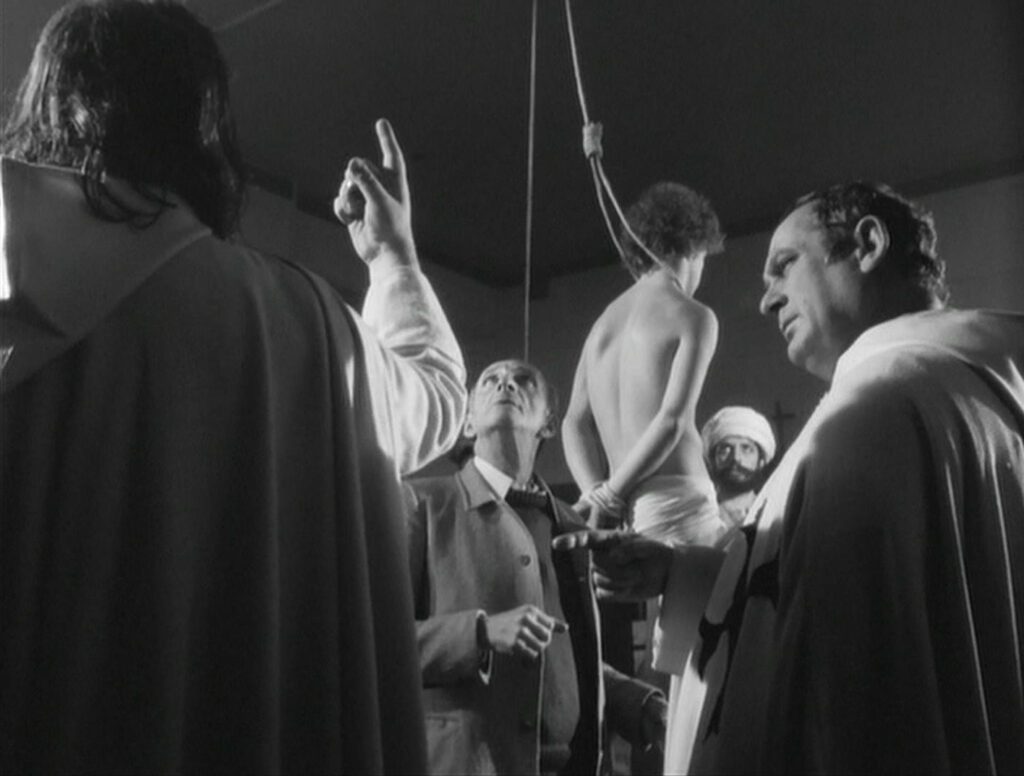
Besides the aforementioned parallels between the Tonnerre paintings and cinema – the elliptical nature of film, the joining of literary and visual expression, and the fundamental strangeness of the audience’s experience – the collector introduces another analog to cinema when he argues with himself over whether the paintings “allude” or “show”. First he says “the paintings did not show, they alluded,” but after speaking about Tonnerre’s defense he reverses the statement: “The paintings did not allude, they showed. They were the ceremony.” But then he immediately reverses himself twice more: “The paintings do not show, they allude. The paintings re-enacted through tableaux vivants do not allude, they show.” This distinction may sound obscure until we recognize it as an alternate formulation of showing vs. telling – a common dichotomy that goes a long way toward accounting for the experience of cinema.
It might seem obvious that films excel at showing above telling, simply because they’re a visual medium, and everyone gets that “a picture is worth a thousand words.” But if a picture is merely reporting information, presenting evidence for empirical review, or attempting to corral the viewer into agreement, it’s not doing much better than telling. To “show” is to win agreement by creating tangency of experience. It says, “Here’s what I’ve experienced – do you experience it too?” When a movie “shows” it does not ask the viewer to submit to the authority of the filmmaker; rather it enlists the viewer as an active participant in the process of exposition or discovery. Raw images tend to “tell” because they’re too forceful, too authoritative. They can be just as deceptive as words. Showing does not ingratiate or make things easy; it challenges the viewer to see beyond what is literally there, and one of the best ways to show is through ellipsis, because it asks the viewer to fill in a gap. Ellipsis is a Socratic technique – it asks questions, and if a question is well formulated then both parties should be able to come to agreement.
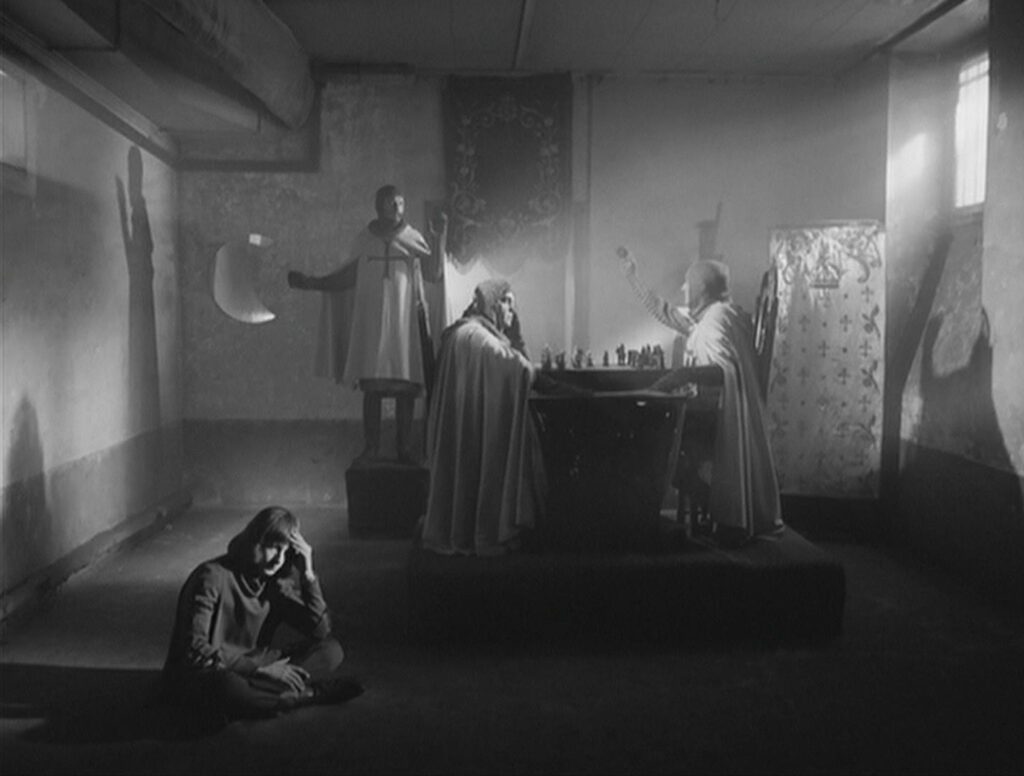
Going back and forth as he does, the collector may sound indecisive, but we might notice that the two times he says the paintings “show”, he puts them in the context of a ceremony. By themselves they merely allude, or point – but when they form a basis for audience participation, they show. This is the ultimate correlation between the Tonnerres and movies, and it accounts for the ceremonial aspect of cinema that The Hypothesis of the Stolen Painting drives at.
The last time the collector says the paintings show, he puts special emphasis on the word (“Ils montrent”). At that moment his head happens to be directly in front of the hunting mirror in the first painting, the object that diverts the sun’s rays into the space of the second painting and thus initiates the chain of hidden connections which concludes, in the seventh painting, with the “blazing sphere”. The path through these paintings, therefore, begins and ends with the sun, a celestial body whose connotations link it with both the act of showing (the sun as a source of illumination) and ancient ritual (the sun as an object of worship). Not coincidentally, the five characters of the fifth painting, the Marquise de I, her niece O, the Marquis de E, O’s male cousin L, and the Señor de H, can be arranged into the Greek root “helio” meaning “sun”. Like the paintings, cinema too begins with and is sustained by a light, the projector’s lamp, a proxy for the sun (not to mention that the inventors’ name Lumière means “light”).
Given how cinematic Tonnerre’s series is, it’s tempting to wonder whether each painting references some important film or director. The crusaders playing chess are straight out of The Seventh Seal, and the disembodied arms holding candelabras in the sixth painting are from Cocteau’s The Beauty and the Beast… or is Cocteau better represented by the ancient Greek spirit of the first painting? The sixth painting, with all of its allusions to the previous five, recalls the French New Wave’s penchant for allusions. The complex melodramatic plot of the fifth painting is like classic Hollywood – a connection reinforced by the fact that it takes up more attention than the others. But the most suggestive citation is outside the paintings. When the collector leads us out through all the silent actors who’ve drifted away from their various tableaux vivants, it’s like the ending of The Cabinet of Dr. Caligari, whose protagonist guides his interlocutor through a hall filled with characters from his story. The plot of Caligari hangs on the one major character missing from that final gathering, just as The Hypothesis of the Stolen Painting hangs on the missing painting.
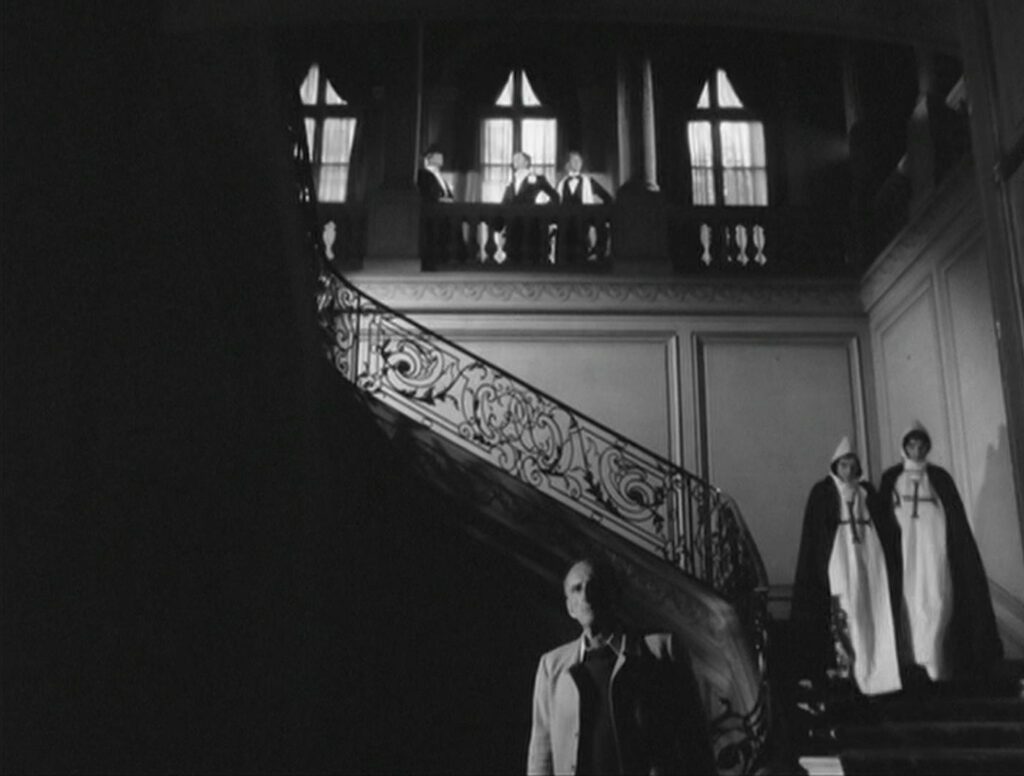
We might also notice a temporal progression in the paintings, from ancient Greece to the Middle Ages to the Inquisition, with a gap for the missing fourth painting, then to the drawing rooms of the late 19th century and beyond. Tonnerre couldn’t have known how to represent the 20th century visually, but the allusiveness of the sixth painting, like the French New Wave, is quintessentially modern, and the series culminates in the primitive future of the seventh painting, about which little is said.
It would be easy to suppose that The Hypothesis of the Stolen Painting is about the process of interpretation. The collector is constantly interpreting, paying close attention to structure and historical context, but he admits at the end that he hasn’t achieved a complete understanding. He hasn’t found the unifying purpose of the series, though the paintings’ relation to a possible ceremony has awakened a wish to investigate further. He senses that they point to something “vast”. He speculates, skeptically, whether the ceremony ends with total warfare and annihilation – acknowledging, like the showman in Warning Shadows, the double-edged nature of his subject. The showman’s shadow play and Tonnerre’s series, these two metaphors for cinema, are capable of both enlightenment and deception. The ending is open, but we should have gained something if we’ve understood that our journey with the collector has not been an abstract intellectual exercise – rather it should sharpen our awareness of what movies can do to us. On one hand we should be suspicious of their occult power; on the other hand we should be ready to look with more intensity at any movie that invites us into a shared experience of wonder and enlightenment.
CONNECTIONS:
The Cabinet of Dr. Caligari – Mystery that hinges on something missing (Alan or the 4th painting); protagonist wanders through a gathering of earlier characters at the end
Warning Shadows – Definition of the power of cinema; warning about its double edge; metaphor for audience absorption
Earth – Cinema as a kind of mystical ceremony
Beauty and the Beast – Candelabras held by disembodied arms in a wall
Tokyo Story – Definition of telling and showing
The Seventh Seal – Crusaders playing chess
The Man Who Left His Will on Film – Search for meaning in inert images
The Cook the Thief His Wife and Her Lover – Series of spaces that represent distinct eras and centuries
The Film to Come – Film as an occult experience
Burning – Rays of sunlight reflected into a room are a key to interpretation